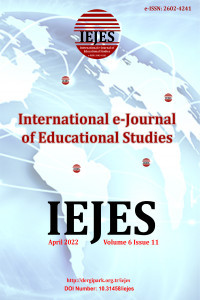Instructors’ Awareness of the Syntactic and Morphological Differences between British and American English
Morphology, syntax, british english, american english
Instructors’ Awareness of the Syntactic and Morphological Differences between British and American English
morphology, syntax, British English, American English,
___
- Algeo, J. (2006). British or american english? A handbook of word and grammar patterns. UK: Cambridge University Press.
- Cambridge Advanced Learners’ Dictionary (2008). Cambridge University Press.
- Colins Cobuild Advanced Learners’ English Dictionary (2006). Harper Colins.
- Farrell, T. & Martin, S. (2009). To teach standard english or world englishes: A balanced approach to instruction. Teaching Forum, 2, 2-7.
- Finnie, R., Frain, C., Hill, D. H., & Thomas, K. (2010). Top grammar: From basic to upper intermediate. Helbling Languages.
- Gramley, S. & Pӓtzold, K. M. (1992). A survey of modern english. London: Routledge.
- Gün, B. (2009). Are teachers fully prepared to teach different varieties of English?: A case study in Turkey. English as an International Language Journal, 5, 164-175.
- Hassan, F. S. (2012). Syntactical and morphological differences in british and american english. Language in India, 12(1).
- Heyl, J. D. & McCarthy, J. (2003). International education and teacher preparation in the U.S. Paper presented at the national conference on Global Challenges and U.S. Higher Education: National Needs and Policy Implications. Duke University, Durham, NC. Retrieved from the Duke University Center for International Studies website: http://ducis.jhfc.duke.edu/archives/globalchallenges/pdf/heyl_abstract.pdf
- Hundt, M. & Smith, N. (2009). The present perfect in British and American English: Has there been any change, recently? ICAME Journal, 33, 45-63.
- Kövecses, Z. (2000). American english: An introduction. Toronto: Broadview Press, McCrum, R., Cran, W., & MacNeil, R. (1986). The story of english. London: BBC publications.
- Rohdenburg, G. & Schlüter, J. (2009). One language, two grammars: Differences between british and american english. UK: Cambridge University Press
- Siemund, P., Davydova, J., & Maier, G. (2012). The amazing world of englishes: A practical introduction. Germany: Walter de Gurter.
- Tirban, N., Precup-Stiegelbauer, L. R., & Patrauta, T. (2012). The major differences between British English and American English in written and oral communication. Communication, Context, Interdisciplinarity (pp.985-990). Tirgu-Mureş, Romania: Universitatea Petru Maior.
- Uygun, D. (2012). Awareness of grammatical variations in English dialects: A survey of Turkish pre-service EFL teachers. In Azamat Akbarov and Vivian Cook (Eds) Contemporary Foreign Language Education: Linking Theory into Practice, (pp.199-206). Sarajevo: IBU Publications.
- Zhang, B. (2008). On grammatical differences between daily british and american english. Asian Social Science, 4(6).
- Başlangıç: 2017
- Yayıncı: Tamer KUTLUCA
The Effect of Reward and Job Satisfaction toward Turnover Intention Private Junior High School
Hardianto HARDİANTO, Rugaiyah RUGAIYAH, Unifah ROSYIDI
Diyan Riski PERMATAHATI, Muhammad Nur WANGID
Lise Öğrencilerinin Çizimlerinden “Ödev” Kavramına ilişkin Düşüncelerinin Analizi
Gülay EKİCİ, Burcu TURGUT, Hasan AKDENİZ
Reasons and Suggested Solutions for Low-Level Academic Achievement in Mathematics
Student Ability for Learning Computer Programming Languages in Primary Schools
Karzan WAKIL, Shanaz KHDIR, Lava SABIR, Lezan NAWZAD
The Difficulties of Theoretical and Applied Learning for Mathematics Subject in Primary Schools
Shwan H. H. ALSHATRI, Karzan WAKIL, Ribwar BAKHTYAR
Guli SHERVASHIDZE, Tamar SIRADZE, Lela TAVDGIRIDZE, Nani MAMULADZE
